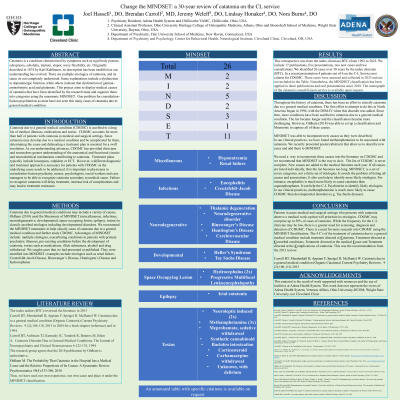Catatonia
Session: Poster Session
(015) Change the MINDSET: a 30-year Review of Catatonia on the C-L Service

Trainee Involvement: Yes
.jpg)
Brendan T. Carroll, MD (he/him/his)
Preceptor
Adena Health System
West Jefferson, Ohio, United States- JH
Joel Hassell, DO
Psychiatry Resident
Adena Health System
Chillicothe, Ohio, United States - NB
Nora K. Burns, DO
Staff Psychiatrist
Cleveland Clinic Foundation
Lakewood, Ohio, United States - LH
Lindsay Honaker, DO
CCF Staff Psychiatrist. Clinical Associate Professor for CCLCM and Case Western Reserve.
Cleveland Clinic Foundation
Cleveland, Ohio, United States 
Jeremy Weleff, DO
Addiction Psychiatry Fellow
Yale University School of Medicine
New Haven, Connecticut, United States
Presenting Author(s)
Co-Author(s)
BACKGROUND Catatonia due to a general medical condition (CDGMC) is ascribed to a long list of medical illnesses, medications and toxins. CDGMC accounts for more than half of patients with catatonia in medical and surgical settings. Since catatonia may develop due to a medical condition and be complicated by them, determining the cause and delineating a treatment plan is essential for a swift resolution. As our understanding advances, CDGMC has provided clinicians and researchers greater understanding of the anatomical and functional circuits and neurochemical mechanisms contributing to Catatonia. Treatment plans typically include lorazepam, zolpidem or ECT. However, a different diagnostic and treatment approach is necessary for patients with CDGMC as the underlying cause needs to be addressed. It is important to physicians in consultation-liaison psychiatry, nurses, psychologists, social workers and case managers to be able to recognize catatonia secondary to medical cause. Failure to recognize catatonia will delay treatment, increase risk of complications and may lead to treatment resistance. METHODS Catatonia due to general medical conditions may include a variety of causes. Oldham used the Mnemonic of MINDSET (miscellaneous, infectious, neurodegenerative, developmental, space-occupying lesion, epilepsy, toxins) to classify ascribed etiologies including developmental disorders. We recommend the MINDSET mnemonic to help classify cases of catatonia due to a general medical condition and further study CDGMC. Advantages of MINDSET include: multiple etiologies, exacerbating conditions in patients with primary psychiatric illnesses, pre-existing conditions before the development of catatonia, toxins such as medications, illicit substances, alcohol and drug withdrawal. We sought cases that we had presented or published. They were stratified into MINDSET; examples include etiologies such as renal failure, Creutzfeldt-Jacob Disease, Binswanger’s Disease, Huntington’s Disease and hydrocephalus. RESULTS This retrospective was from the index clinician (BTC) from 1992 to 2022. We include 14 publications, five presentations, two new cases and two consultations. We identified 24 cases over 30 years by the index clinician (BTC). In a recent presentation, 4 patients out of 6 on the C-L Service met criteria for CDGMC. The frequency of CDGMC may be very high for those who spend a greater amount of time on the medical floors such as consultation liaison fellows and psychiatrists. CONCLUSION There is a greater need for screening, diagnosis and detection of CDGMC. There is a need for more research into CDGMC using the MINDSET Stratification. Patients in acute medical and surgical settings who present with catatonia deserve a medical work-up that will prioritize CNS etiologies. REFERENCES Llesuy, J R, Medina, M, Jacobson, KC, Cooper, JJ. Catatonia under-diagnosis in the general hospital. The Journal of Neuropsychiatry and Clinical Neurosciences 2018; 30(2), 145-151. Oldham M. The Probability That Catatonia in the Hospital has a Medical Cause and the Relative Proportions of Its Causes: A Systematic Review. Psychosomatics 2018; 59(4):333-340.
DISCUSSION
Recognizing the need to determine the cause and delineate a treatment plan, the 4 C’s of the treatment of catatonia due to a general medical condition should be utilized; Treatment directed at Catatonia, the Comorbid conditions, the medical Cause and the Complications.

